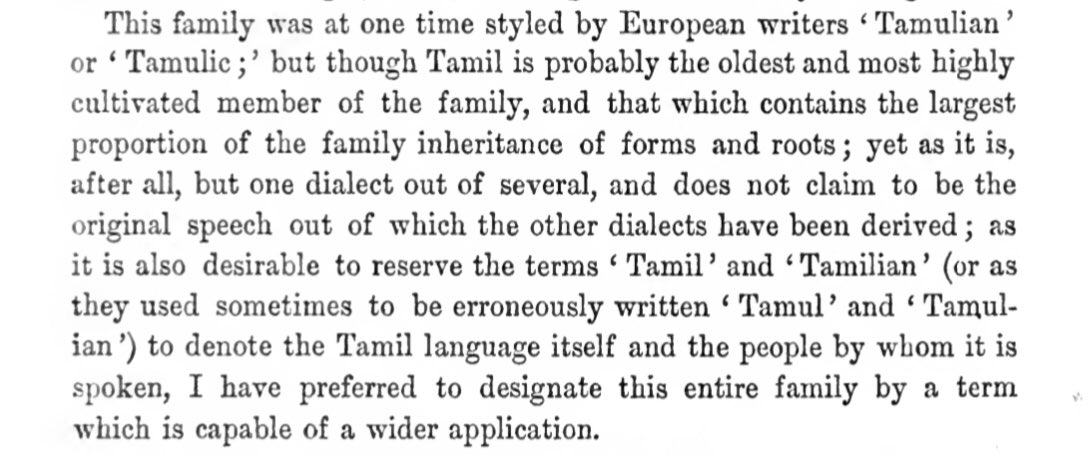
Name #Dravidian for lang family was coined by Robert Caldwell who discussed this at length in “A Comparative Grammar of the Dravidian or South-Indian Family of Languages”1856
He gives his rationale-justification, also cleverly sowing seeds for today’s “Dravidian movement”
1/15
He gives his rationale-justification, also cleverly sowing seeds for today’s “Dravidian movement”
1/15

He sort of acknowledges Francis Whyte Ellis & Stevenson for recognising that today’s “#Dravidian” languages had much common between them, distinct from samskRta.
Ellis noted this in his intro to Alexander D Campbell’ book, “Grammar of the Teloogoo Language” (1816)
2/15
Ellis noted this in his intro to Alexander D Campbell’ book, “Grammar of the Teloogoo Language” (1816)
2/15

But the idea of putting tamiZ at the centre of this language, giving it a disproportionately large importance wasn’t just Caldwell’s. He mentions the use of “tamulic” and “tamulian” for this family by European writers prior to him.
#Dravidian
3/15
#Dravidian
3/15

The tamiZ speaking regions being directly under colonial rule with Madras as the administrative capital, and due to these being the bone of contention between various European colonisers sure made them more familiar with, & lay emphasis on tamiZ
#Dravidian
4/15
#Dravidian
4/15
Caldwell goes on to justify his choice of #Dravidian as the name of the lang family. He quotes kumārila bhaṭṭa using āndhra-drāviḍa-bhāṣā. He then gratuitously adds his retrospective erroneous views on this use-that kannaDa was included in telugu, & Malayalam in tamiZ
5/15

5/15


He was clearly wrong on both counts. āndhra was never used to refer to kannaDa-karnāṭa region/lang. karnāṭa is found often in early samskRta literature
Malayalam did not exist in 7th C CE, when kumārila lived
kumārila was too well-read & travelled not to have known
6/15
Malayalam did not exist in 7th C CE, when kumārila lived
kumārila was too well-read & travelled not to have known
6/15
He further quotes manu using drāviḍa as one of several fallen kṣatriya tribes. Again, with no evidence, he concludes that this was used as a common term for all South Indians. He again makes erroneous assumptions about only telugu/ āndhra being possibly excluded frm this
7/15

7/15


Caldwell’s relative ignorance of kannaDa is evident from how many pages he has dedicated to the summary of each language in his book.
Tamil 11.5 pages
Malayalam 9
Telugu 4
KannaDa 1.5 (!)
tuLu 1
koDava 1
#Dravidian
8/15
Tamil 11.5 pages
Malayalam 9
Telugu 4
KannaDa 1.5 (!)
tuLu 1
koDava 1
#Dravidian
8/15
Here Caldwell plays on plausibility- suggestibility, that the North Indian writers supposed all South Indian languages as “one tongue”.
Like “Madrasi” today? But is he right though?
Is drāviḍa/drāviḍī a name of South Indian lang(s) or in fact a form of Prakrit itself?
9/15
Like “Madrasi” today? But is he right though?
Is drāviḍa/drāviḍī a name of South Indian lang(s) or in fact a form of Prakrit itself?
9/15

And here is some casually dropped in #Brahmin-bashing. Got to give it to him for knowing exactly where to hit! And thus were sowed the seeds that in latter days flowered as the “Dravidian movement”
Such suggestions are sprinkled elsewhere too from time to time
#Dravidian
10/15
Such suggestions are sprinkled elsewhere too from time to time
#Dravidian
10/15

Caldwell also quotes varāhamihira, but acknowledges harbour is unclear if his use of the term drāviḍa was generic or specific
#Dravidian
11/15
#Dravidian
11/15

There‘s one valid point he makes- the use of the term pañcadrāviḍa in older samskRta literature to include draviḍa, karnāṭa, āndhra, mahārāṣṭra & gūrjara people/clans. In this term, draviḍa is used generally to refer to what were considered related groups
#Dravidian
12/15
#Dravidian
12/15
What this common relationship was is unclear? D’you know?
Tempting to think it’s based on linguistic insights but that’s most unlikely (marAThi Gujarati have significant #Dravidian substrate-admixture). There’s no evidence that ancient people saw Dravidian langs as related
13/15
Tempting to think it’s based on linguistic insights but that’s most unlikely (marAThi Gujarati have significant #Dravidian substrate-admixture). There’s no evidence that ancient people saw Dravidian langs as related
13/15
Caldwell makes just that above point- tho there were countless scholars that knew their lang deeply, they didn’t quite see (or if they did, they didn’t record it) that another lang was from the same source. None of the #Dravidian langs have a common term for the family
14/15
14/15

So he makes his final point to justify the use of the name #Dravidian for the language family
The question is, today, how commonly is the term “Dravida” understood as tamiZ
What could be a viable alternative name for the family? (It is not restricted to South India)
15/15
The question is, today, how commonly is the term “Dravida” understood as tamiZ
What could be a viable alternative name for the family? (It is not restricted to South India)
15/15

This tweet thread was in response to the tweet below 👇
@maidros78 @hamsanandi @talekaayi @a_srinidhi
@maidros78 @hamsanandi @talekaayi @a_srinidhi
https://twitter.com/maidros78/status/1329620347973300224
• • •
Missing some Tweet in this thread? You can try to
force a refresh




